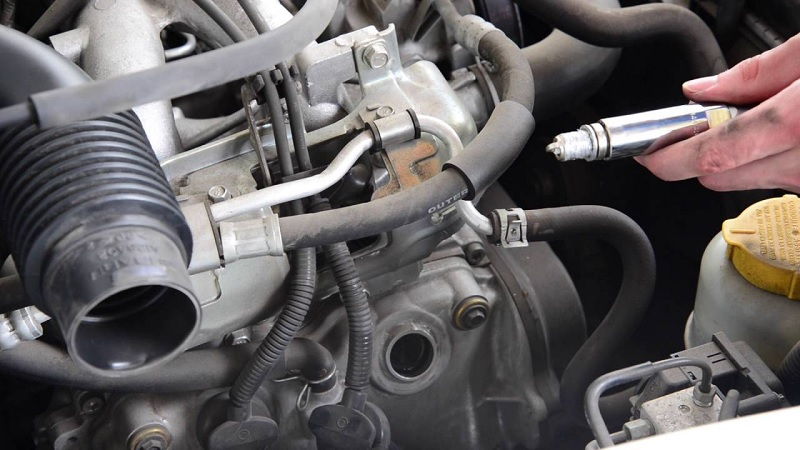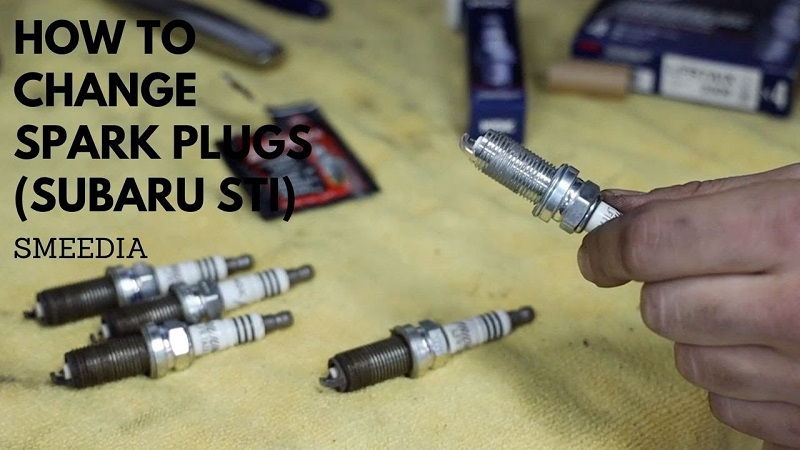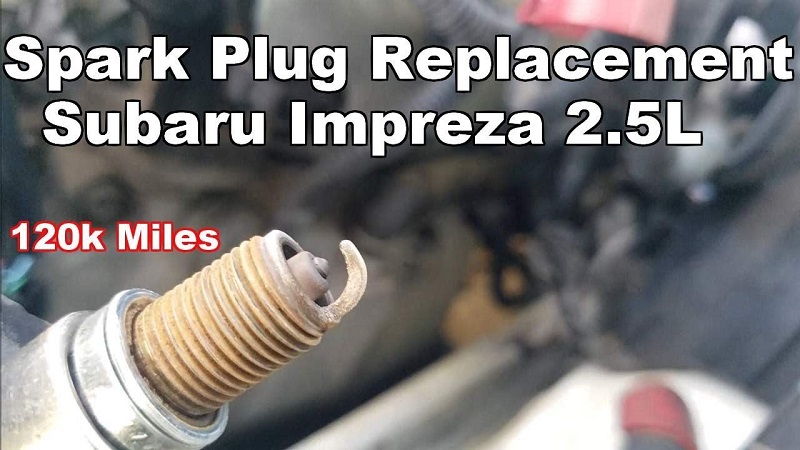This post contains affiliate links. This means I will make a commission at no extra cost to you should you click through and make a purchase [ “As an Amazon Associate, I earn from qualifying purchases.” ]. Read the full disclosure here.
Subaru Spark Plug Replacement GuideMechanic.Com Are you a proud Subaru owner looking to ensure your vehicle’s optimal performance? One crucial aspect to consider is the regular maintenance and replacement of spark plugs.
In this comprehensive guide, we will delve into the importance of spark plug replacement for Subarus, the signs indicating it’s time for a change, and a step-by-step process to help you seamlessly replace them. So, let’s dive in and unveil the secrets to maintaining your Subaru’s efficiency and longevity!
First and foremost, understanding the significance of spark plugs in your Subaru’s engine is essential. These small yet mighty components play a vital role in igniting the air-fuel mixture within the combustion chamber, generating the power needed to propel your vehicle.
See Also: Champion RJ19LM Cross Reference
Over time, spark plugs can wear out due to extreme heat, deposits, or general wear and tear. Failing to replace them at the appropriate intervals can lead to decreased fuel efficiency, engine misfires, and even potential damage to other engine components.
The Importance of Regular Spark Plug Replacement

Regular spark plug replacement is crucial for maintaining your Subaru’s performance. As spark plugs age, their ability to generate a strong spark diminishes, leading to inefficient combustion.
This inefficient combustion can result in decreased fuel efficiency, reduced engine power, and even engine misfires.
By replacing your spark plugs at the recommended intervals, you ensure that your Subaru continues to perform optimally, maximizing fuel efficiency and power output.
Maximizing Fuel Efficiency
Worn-out spark plugs can cause incomplete combustion, resulting in wasted fuel. This inefficiency can lead to increased fuel consumption and higher expenses at the pump.
By replacing your spark plugs regularly, you promote complete combustion, ensuring that every drop of fuel is utilized efficiently. This, in turn, helps you achieve better fuel efficiency, saving you money in the long run.
Optimizing Engine Power
When spark plugs wear out, they struggle to generate a strong spark, leading to incomplete combustion. This incomplete combustion can result in reduced engine power, making your Subaru feel sluggish and less responsive.
By replacing your spark plugs, you ensure a strong and consistent spark, maximizing power output and enhancing your driving experience.
Preventing Engine Misfires
Worn-out spark plugs increase the likelihood of engine misfires, which can be both frustrating and potentially damaging to your Subaru’s engine.
See Also: Torch F6RTC to Champion
Engine misfires occur when the air-fuel mixture fails to ignite properly. By replacing your spark plugs at the recommended intervals, you minimize the risk of engine misfires, promoting smooth and reliable engine operation.
Signs that Indicate the Need for Spark Plug Replacement
Recognizing the signs that it’s time to replace your Subaru’s spark plugs is crucial for maintaining optimal performance. Here are some common indicators that your spark plugs may need replacement:
Rough Idling
If you notice your Subaru’s engine idling roughly or vibrating more than usual, it could be a sign of worn-out spark plugs. As spark plugs age, they struggle to generate a consistent spark, leading to uneven combustion and a rough idle.
Decreased Acceleration
Worn-out spark plugs can cause a decrease in acceleration and overall engine power. If you find that your Subaru is not as responsive as it used to be, it may be time to replace the spark plugs. New spark plugs ensure a strong and consistent spark, maximizing power output.
Increased Fuel Consumption
One of the most noticeable signs of worn-out spark plugs is increased fuel consumption. When spark plugs are unable to generate a strong spark, fuel combustion becomes inefficient, resulting in wasted fuel. If you find yourself visiting the gas station more frequently, it may be time to replace your spark plugs.
Difficulty Starting the Engine
If you experience difficulty starting your Subaru’s engine, especially in cold weather, worn-out spark plugs could be the culprit. Faulty spark plugs struggle to ignite the air-fuel mixture, leading to prolonged cranking and potential starting issues.
Poor Fuel Mileage
Another sign of deteriorating spark plugs is a noticeable decrease in fuel mileage. If you find that your Subaru’s fuel efficiency has dropped significantly, it’s worth considering spark plug replacement. By ensuring efficient combustion, new spark plugs can help restore your Subaru’s fuel economy.
Gathering the Tools and Materials

Before diving into the spark plug replacement process, it’s essential to gather all the necessary tools and materials. Here’s a comprehensive list of what you’ll need:
Tools:
- Ratchet wrench
- Socket set
- Spark plug socket
- Extension bar
- Spark plug gap tool
- Wire brush or spark plug cleaner
- Anti-seize compound (recommended)
- Torque wrench (optional, but recommended)
Materials:
- New spark plugs (compatible with your Subaru’s model and engine)
- Dielectric grease (recommended)
- Cloth or towel for cleaning
Locating and Accessing the Spark Plugs
Locating and accessing the spark plugs in your Subaru’s engine may vary depending on the model and engine configuration. Here’s a general guide to help you find the spark plugs:
Step 1: Consult the Owner’s Manual
Start by consulting your Subaru’s owner’s manual for specific instructions on locating the spark plugs. The manual will provide you with the necessary information, including the exact location and any specific steps for accessing the spark plugs.
Step 2: Open the Hood and Locate the Engine
To access the spark plugs, you’ll need to open the hood of your Subaru and locate the engine. The engine is usually positioned towards the front of the vehicle, beneath the hood. Take a moment to familiarize yourself with the engine’s layout.
Step 3: Identify the Spark Plug Wires
The spark plug wires are a crucial component in delivering the electrical current from the ignition system to the spark plugs.
See Also: 2015 Chevy Cruze Spark Plugs: Step-by-Step Replacement
They are usually connected to the top of the spark plugs. Identify the spark plug wires by following them from the ignition coil or distributor to the spark plugs.
Step 4: Remove Any Engine Covers or Components
In some Subaru models, there may be engine covers or components that need to be removed to access the spark plugs. Carefully remove any covers or components as instructed in your owner’s manual, ensuring not to damage any surrounding parts.
Step 5: Locate and Access the Spark Plugs
With the engine exposed, you should now be able to locate the spark plugs. Depending on your Subaru’s engine configuration, the spark plugs may be positioned on the top or sides of the engine cylinders. Look for small, cylindrical components with attached spark plug wires.
Removing the Old Spark Plugs

Now that you’ve located the spark plugs, it’s time to remove the old ones. Follow these steps to safely remove the old spark plugs from your Subaru:
Step 1: Prepare the Area
Before removing the spark plugs, make sure the area around them is clean and free of debris. Use a cloth or towel to wipe away any dirt or grime that may fall into the engine cylinders during the removal process.
Step 2: Remove the Spark Plug Wires
Start by carefully disconnecting the spark plug wires from the old spark plugs. To do this, firmly grasp the spark plug wire boot (the rubber part) and twist it gently while pulling it away from the spark plug. Avoid pulling on the wire itself, as this can damage the wire or the connection.
Step 3: Loosen and Remove the Old Spark Plugs
Using a ratchet wrench, socket set, and spark plug socket, loosen the old spark plugs by turning them counterclockwise. Once they are loosened, continue turning them by hand until you can remove them completely from the engine cylinders. Take note of the condition of each spark plug as you remove them.
Step 4: Inspect the Old Spark Plugs
Take a moment to inspect the old spark plugs for any signs of wear, deposits, or damage. Pay attention to the electrode, which should have a consistent color and minimal deposits.
See Also: Spark Plug and Coil Replacement Cost
Excessive wear, unusual deposits, or damaged electrodes indicate potential issues that may require further inspection or maintenance.
Inspecting and Preparing the New Spark Plugs
Before installing the new spark plugs, it’s crucial to inspect them for any potential issues and prepare them accordingly. Follow these steps to ensure your new spark plugs are ready for installation:
Step 1: Check for Compatibility
Ensure that the new spark plugs are compatible with your Subaru’s specific model and engine. Refer to your owner’s manual or consult a trusted automotive parts store to confirm the correct spark plug specifications for your vehicle.
Step 2: Inspect the NewSpark Plugs
Before installing the new spark plugs, carefully inspect each one for any visible defects or damage. Look for cracks, chips, or any other irregularities that may affect their performance. Additionally, check that the electrode gap matches the specifications recommended by the manufacturer.
Step 3: Adjust the Spark Plug Gap
If necessary, adjust the spark plug gap to meet the manufacturer’s specifications. The electrode gap refers to the distance between the center electrode and the ground electrode.
Use a spark plug gap tool to carefully widen or narrow the gap as required. It’s crucial to be gentle during this process to avoid damaging the electrodes.
Step 4: Apply Anti-Seize Compound (Optional)
Applying a small amount of anti-seize compound to the spark plug threads is optional but recommended.
This compound helps prevent the spark plugs from seizing or sticking in the engine cylinder, making future removal easier.
Be sure to apply the compound sparingly and only to the threads, avoiding contact with the electrode or other parts of the spark plug.
Installing the New Spark Plugs
Now comes the exciting part – installing the new spark plugs! Follow these steps to ensure a proper and secure fit for optimal performance:
Step 1: Insert the New Spark Plugs
Carefully thread the new spark plugs into the engine cylinders by hand. Start by turning them clockwise to avoid cross-threading. Once they are threaded in securely, use a spark plug socket and ratchet wrench to tighten them further.
It’s important not to overtighten the spark plugs, as this can damage the threads or the engine cylinder. Refer to the manufacturer’s specifications or consult your owner’s manual for the recommended torque value.
Step 2: Apply Dielectric Grease
Applying a thin layer of dielectric grease to the inside of the spark plug wire boot is recommended. This grease helps create a moisture-resistant seal, preventing moisture from interfering with the spark plug’s performance. Be sure to apply the grease sparingly, as excessive amounts can cause issues with electrical conductivity.
Step 3: Reconnect the Spark Plug Wires
With the new spark plugs installed, it’s time to reconnect the spark plug wires. Firmly push the spark plug wire boot onto the new spark plug until you feel a slight click or resistance. Ensure that the boot is securely seated, as a loose connection can lead to misfires or poor performance.
Reassembling and Testing
After successfully installing the new spark plugs, it’s important to reassemble any components that were removed and conduct a thorough performance test. Follow these steps to complete the process:
Step 1: Reassemble Engine Covers or Components
If you removed any engine covers or components to access the spark plugs, carefully reattach them following the instructions provided in your owner’s manual. Ensure that all fasteners are tightened securely to prevent any potential issues while driving.
Step 2: Perform a Test Start
Before taking your Subaru for a drive, perform a test start to ensure that the engine starts smoothly. Turn the ignition key or press the start button and listen for any unusual noises or vibrations. If everything sounds and feels normal, proceed to the next step.
Step 3: Conduct a Performance Test
Take your Subaru for a short drive to evaluate its performance after the spark plug replacement. Pay attention to acceleration, engine responsiveness, and overall smoothness.
See Also: 2004 Honda Accord Spark Plugs
If you notice any issues or abnormalities, it may be necessary to recheck the spark plug installation or seek professional assistance.
Maintenance Tips for Prolonged Spark Plug Lifespan
To maximize the lifespan of your Subaru’s spark plugs and ensure optimal performance, consider implementing the following maintenance tips:
Use High-Quality Fuel
Using high-quality fuel can minimize the buildup of deposits on the spark plugs and prolong their lifespan. Quality fuels contain fewer impurities that can cause fouling or damage to the spark plugs.
Regular Engine Check-ups
Regular engine check-ups, including scheduled maintenance and inspections, can help identify potential issues before they escalate. A professional technician can assess the condition of your spark plugs and recommend replacement when necessary.
Follow Manufacturer’s Recommendations
Always refer to your Subaru’s owner’s manual for the manufacturer’s recommended spark plug replacement intervals. Following these guidelines ensures that you stay on top of maintenance and replace the spark plugs at the appropriate times.
Keep the Engine Clean
Maintaining a clean engine can help prevent the accumulation of debris or contaminants that can affect spark plug performance. Regularly clean the engine bay, paying attention to areas around the spark plugs, to minimize the risk of debris interfering with their operation.
Frequently Asked Questions (FAQs)
Here are some commonly asked questions and concerns related to Subaru spark plug replacement:
Q: Can I replace the spark plugs myself, or should I go to a professional?
A: Spark plug replacement can be performed by individuals with basic automotive knowledge and the necessary tools. However, if you’re unsure or uncomfortable with the process, it’s recommended to seek professional assistance to ensure the job is done correctly.
Q: How often should I replace the spark plugs in my Subaru?
A: The replacement interval for spark plugs varies depending on the specific model and engine of your Subaru. Refer to your owner’s manual for the manufacturer’s recommended interval, typically ranging from 30,000 to 100,000 miles.
Q: Can I mix different brands or types of spark plugs in my Subaru?
A: It’s generally recommended to use the same brand and type of spark plugs as specified by the manufacturer. Mixing different brands or types can potentially affect performance and compatibility.
Q: Can I reuse old spark plugs?
A: Reusing old spark plugs is not recommended. Even if they appear to be in good condition, their performance may have significantly degraded. It’s always best to install new spark plugs for optimal performance and reliability.
In conclusion, replacing the spark plugs in your Subaru is a crucial maintenance task that directly impacts its performance and efficiency.
By following this comprehensive guide, you can confidently undertake the spark plug replacement process and ensure your Subaru continues to run smoothly for miles to come.
Remember, maintaining your Subaru’s spark plugs is a small investment that yields significant returns in terms of engine performance and longevity. So, roll up your sleeves, grab your tools, and let’s get your Subaru running at its best!
Related video of Subaru Spark Plug Replacement: A Comprehensive Guide for Optimal Performance
- Food Trucks for Sale in Las Vegas NV - July 4, 2025
- Food Trucks for Sale Near Me Ready to Use - July 3, 2025
- Used Food Trucks for Sale in New York - July 3, 2025

